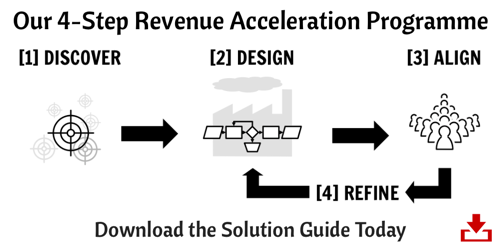The problem with assigning fixed percentages to pipeline stages
July 2, 2015

 On average, fewer than 50% of forecasted opportunities close at the predicted value and time - and the figure is usually far worse in early stage companies without an established track record of successfully closing business.
On average, fewer than 50% of forecasted opportunities close at the predicted value and time - and the figure is usually far worse in early stage companies without an established track record of successfully closing business.
Its no wonder that revenue forecast accuracy is a huge frustration for CEOs and a frequent source of tension with both their Board of Directors and their sales leadership. After all, how hard can it be to work out when an opportunity a sales person been pursuing for months is going to close?
The answer of course - as anyone in frontline sales knows all too well - is that accurate sales forecasting is one of the most significant sales challenges, compounded by the fact that sales is a profession that tends to attract more optimists than pessimists.
But despite these acknowledged difficulties, I still see organisations implement processes that make it even harder than it needs to be to judge the true state of the pipeline and the likelihood of converting opportunities into revenue.
Blame it on the CRM vendors
It’s not just the CRM users' fault. The traditional CRM vendors bear a huge burden of responsibility for this - by encouraging their customers to believe that it is possible to assign a generic probability to individual deals based on their current stage in the pipeline.
Whilst this approximation may be close enough to the truth in a high volume, low value, well-established transactional sales environment, it completely fails to reflect the complexities of high value, long sales cycle complex sales environments.
Why the maths don't add up...
Allow me to illustrate with a simple example: it’s not unusual for the “proposal” stage to carry a default 50% probability. Now let’s assume that a minimum of three organisations are invited to propose - and they each rate the opportunity the same way in their respective CRM systems.
Let’s further assume that there is a normal 50/50 chance that the prospect will actually end up deciding to do nothing and stick with the status quo. If you do the maths, together they add up to a 300% probability of doing business. How can that make any sense?
The problem is of course compounded by the fact that almost inevitably one of the three options is actually in the driving seat, and the other two are simply there to make up the numbers. Can you see why probabilities based on sales stage are such a nonsense?
But what are the alternatives? Well, the simplest approach - which can somewhat improve forecasting, even if it does not eliminate the root cause - is to adjust the “out-of-the-box” stage percentages to accurately reflect your real-life experience.
A more effective approach
But there are far better ways of dealing with the issue, although they involve more work. The two elements are to:
- Base pipeline management stages on observable milestones in your prospect’s buying decision process, and adjust probability up or down based on the likelihood that they will do anything
- Further adjust opportunity percentages up or down individually based on factors that directly influence your chances of winning the business
Let’s look at the implications of these two strategies...
The buying decision process as a framework
Most complex B2B buying decisions evolve through a series of identifiable stages:
- First there is no problem, and no project
- Then the prospect becomes aware of an issue
- Then the prospect determines whether they need to take action
- Then the prospect develops their vision of what a solution should look like
- Then the prospect selects the best available option
- Then the prospect confirms their decision
- Then the prospect places an order on their chosen vendor
Of course, the prospect can choose to move forward, stick where they are, return to a previous stage or drop out of the process at any time - and this is made more complex with the involvement of multiple stakeholders. But if you know what you are looking for, it is relatively easy to work out what stage the prospect has currently reached in their buying decision process.
What are the chances they will do anything?
Then we’ve got the chance they will actually do anything. Again, if you know what to ask and what to look for, it’s possible to make an informed judgement about this by considering issues like:
- Have we identified a clear economic case for change?
- Have we identified business drivers that make addressing the issue urgent?
- How important is this project relative to other potential initiatives?
- How powerful is our sponsor in mobilising the rest of the organisation?
- Do we understand “what’s in it for me” for each of the stakeholders?
- Does the process have momentum or does it seem to have stalled?
The percentage probability they will do anything is a function of where they are in the process and how likely it is that they will decide to act.
Your chances of winning their business
Once again, your chances of winning their business should they decide to go ahead with the project is typically affected by a handful of critical issues:
- How good a fit is our solution against their identified problem?
- To what extent did we help to shape the economic case for change?
- To what extent did we help to shape their vision of a solution?
- At what stage did we get engaged in their decision process (earlier is better)?
- To what extent have they agreed that our solution offers unique advantages?
- What is our level of engagement with each of the key stakeholders?
The probability they will decide to choose you is a function of how good a fit you have against each of the above factors.
Isn’t this over-complicating matters?
If this seems more complicated than relying on standard percentages, well of course it is - and if standard percentages are resulting in accurate revenue forecasts you should stick with the simple approach. But if - as is the case in most complex sales environments - the standard percentages are NOT generating accurate sales forecasts, then you need to seriously consider changing your process.
To sales people who might complain that this is yet another bunch of data to capture that no one is ever going to look at, I'd simply say the following:
- If you genuinely believe that you can maximise your chances of winning without knowing this information, you are clearly a magician and should pursue a career on the stage or join one of our competitors
- The reason why we are asking for this is that we know that the information is critical, so you can be sure that management will be paying very close attention to it
Inevitably, you won’t get this completely right to start with - but you’ll get way closer than you would under the traditional approach, and you’ll be able to continuously refine your assumptions based on an analysis of the real-life predictive value of the key factors.
You’ll uncover additional factors that are specific to your business environment, and with experience you’ll almost certainly find that a handful of key factors have the most significant impact - so can focus your sales people’s attention on them.
Or would you rather stick with the status quo, and preserve the illusion that the weighted value of your pipeline bears any relationship to reality?



Comments